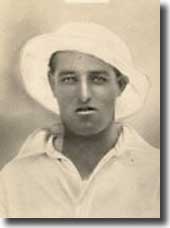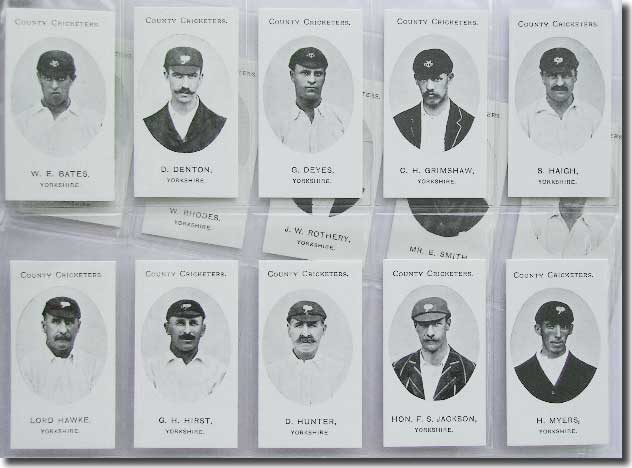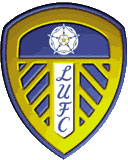 Though
William Bates enjoyed only moderate success as a footballer, he became
an outstanding cricketer when he switched codes permanently, and was a
member of a celebrated sporting family. His father was a respected cricketing
all rounder with Yorkshire and England and his son Ted enjoyed a lengthy
football career as player and manager with Southampton.
Though
William Bates enjoyed only moderate success as a footballer, he became
an outstanding cricketer when he switched codes permanently, and was a
member of a celebrated sporting family. His father was a respected cricketing
all rounder with Yorkshire and England and his son Ted enjoyed a lengthy
football career as player and manager with Southampton.
Father Billy, born in November 1855 in Lascelles Hall, Huddersfield,
excelled with both bat and ball, scoring more than 10,000 first class
runs and taking almost 900 wickets. Nicknamed The Duke because of his
sharp dress sense, he became a professional cricketer with Rochdale in
1873 and made his first class debut for Yorkshire four years later. In
1879 he took a career best 8-21 at the Oval against Surrey. He played
fifteen Test matches for England between 1881 and 1887, all of them in
Australia.
His greatest performance was at Melbourne on the 1882-83 tour when he
scored 55 before taking 7-28 in Australia's first innings, including a
hat trick. He then returned 7-74 when the Aussies followed on to seal
England's win. It was the first ever innings victory in Test cricket and
the first hat trick by an England player in a Test match. The 7-28 in
the first innings and match tally of 14 wickets were the best ever by
a Test bowler and it was the first time anyone had taken 10 or more wickets
and scored 50 in the same match.
Bates' career came to a tragic end. On a tour of Australia with G F Vernon's
XI in 1887-88, when bowling in the nets on Christmas Eve, he was hit in
the eye by a ball struck by a teammate. He was sent straight back to England
but specialists declared the damage irreparable and Bates had to retire
from the first class game.
After retirement, Bates invested in a sports shop but it failed and he
fell into a deep depression and on 24 January 1889 he tried to commit
suicide. At the end of February he was charged with attempted suicide
and convicted, but the judge let him off.
Many of his friends, ex colleagues and the Yorkshire club rallied together
and £1000 was raised which was invested to give him a weekly income. Fellow
Lascelles Hall and Yorkshire player Ephraim Lockwood talked him into taking
up billiards and he became a decent player picking up regular purses this
way. Tragedy again struck when wife Sarah died at the age of 28. In December
1899 he caught a cold while attending the funeral of Yorkshire teammate
John Thewlis and died a few days later, aged 44.
At the time his son, William Edric Bates, born at Kirkheaton, near Huddersfield,
on 5 May 1884, was 15. William showed an aptitude from an early age for
both football and cricket; he began his soccer career as a centre-forward
with First Division Bolton Wanderers in 1906, playing two games for the
club.
He returned to Yorkshire in 1907, dropping
a division to sign for Leeds City and turning out in the summer months
for Yorkshire CCC.
By now he had been converted to full-back and he made fifteen first team
appearances for the Second Division club over the next two seasons.
Bates made his City debut in April 1908 against Stockport County. Leeds
won 3-0 and he retained his place for the following two games.
Flaneur described him thus in the Leeds Mercury: 'Bates may not
place with great accuracy, but how many Leeds City men do? On the other
hand, he gets the ball away under all sorts of difficulties; he rarely
miskicks; and his speed and strong tackling make him a really valuable
man.' Wanderer later wrote in the same paper: 'Although  still
a little wild, he acquitted himself well. His chief fault lay in getting
in the way of the custodian too much, and it is a fault he should quickly
remedy, for a goalkeeper requires as much breathing space as it is possible
to give him.' Bates featured once at outside-right, against Wolves in
April 1909, but was not a success, Wanderer describing him as a 'fish
out of water'.
still
a little wild, he acquitted himself well. His chief fault lay in getting
in the way of the custodian too much, and it is a fault he should quickly
remedy, for a goalkeeper requires as much breathing space as it is possible
to give him.' Bates featured once at outside-right, against Wolves in
April 1909, but was not a success, Wanderer describing him as a 'fish
out of water'.
Bates never really fulfilled his promise as a footballer, and in 1909
he ended his stay at Elland Road and switched full-time to cricket.
Bates became a prolific opening bat, scoring a number of centuries and
often beating the thousand run mark for the season. He was also a useful
left arm spinner, taking 8-93 against Essex in 1928, and was a reliable
fielder close to the wicket.
Bates played for Yorkshire from 1907 to 1913, scoring 2,634 runs with
a highest score of 81. He joined Briton Ferry as a professional in 1914,
which qualified him to play for Glamorgan, where he remained until 1931.
In 1923 he scored a thousand runs for the season, without scoring a century,
whilst in 1927 he became the first Glamorgan batsman to record a century
in each innings, with 105 and 111 against Essex. He also scored 200 against
Worcestershire at Kidderminster and finished the summer with 1,645 runs
to his name. He passed the 1,500 run mark again in 1928, and began a most
prolific partnership with fellow Tyke, Arnold Dyson. The pair took great
delight in sharing a stand of 233 for the first wicket against Yorkshire
at Sheffield in 1930.
Glamorgan's financial difficulties led to the club releasing him in 1931.
He had scored 15,964 first class runs in 406 matches and taken 230 wickets
with a career best of 8-93.
He continued to play for Cheshire in minor counties cricket before becoming
a coach and groundsman in Northern Ireland, where he died on 17 January
1957.
Son Edric Thornton 'Ted' Bates played inside-forward for Southampton
from 1937 to 1952, making more than 200 league appearances. He was manager
at the Dell from 1955 to 1973, later becoming a club director and then
president. He was honoured with the MBE in 1998 for services to football
and received the freedom of the city that same year.
back to top











 Though
William Bates enjoyed only moderate success as a footballer, he became
an outstanding cricketer when he switched codes permanently, and was a
member of a celebrated sporting family. His father was a respected cricketing
all rounder with Yorkshire and England and his son Ted enjoyed a lengthy
football career as player and manager with Southampton.
Though
William Bates enjoyed only moderate success as a footballer, he became
an outstanding cricketer when he switched codes permanently, and was a
member of a celebrated sporting family. His father was a respected cricketing
all rounder with Yorkshire and England and his son Ted enjoyed a lengthy
football career as player and manager with Southampton. still
a little wild, he acquitted himself well. His chief fault lay in getting
in the way of the custodian too much, and it is a fault he should quickly
remedy, for a goalkeeper requires as much breathing space as it is possible
to give him.' Bates featured once at outside-right, against Wolves in
April 1909, but was not a success, Wanderer describing him as a 'fish
out of water'.
still
a little wild, he acquitted himself well. His chief fault lay in getting
in the way of the custodian too much, and it is a fault he should quickly
remedy, for a goalkeeper requires as much breathing space as it is possible
to give him.' Bates featured once at outside-right, against Wolves in
April 1909, but was not a success, Wanderer describing him as a 'fish
out of water'.